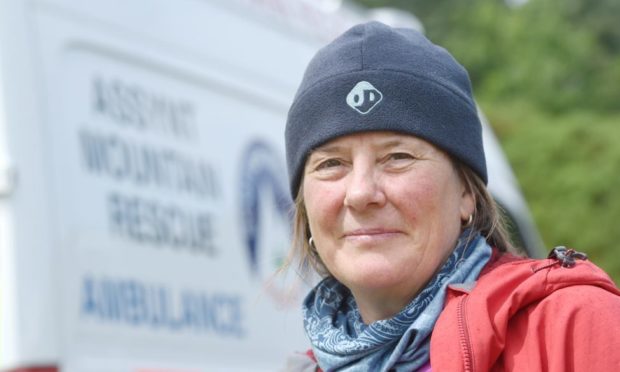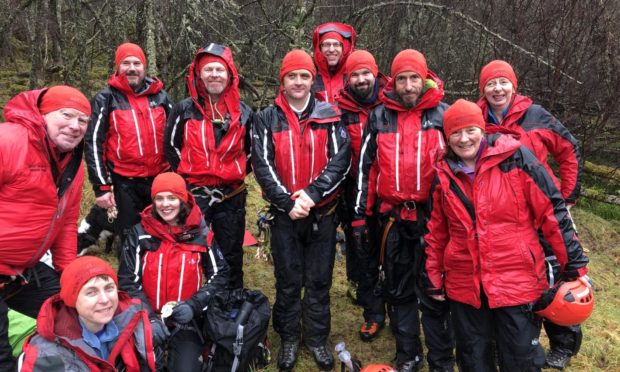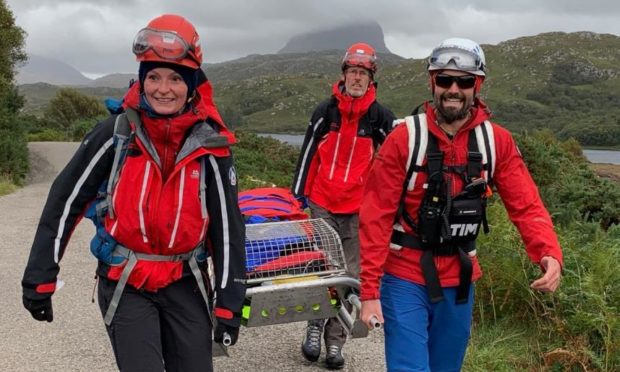Sue Agnew grew up walking and climbing in the hills, but she took her interest to new heights after seeing a friend suffer life-changing injuries on an expedition.
The incident happened more than 20 years ago in Glen Clova when she found herself unable to help her fallen colleague.
“I don’t like sitting back and letting other people get on with things. I want to find a way of getting involved and helping. I was shocked at that incident as I didn’t know what to do; I didn’t know about first aid, or how to call the emergency services. It was a change in my life definitely.”
She decided to join a mountain rescue team to learn the skills she needed if she was ever in a similar position again.
Scotland’s only female mountain rescue team leader
Since then she has found herself in emergencies many times as a member of Assynt Mountain Rescue Team which covers some of Scotland’s most remote and challenging hills across Caithness and Sutherland.
Now she is standing down after eight years as team leader, the only female rescue team leader in Scotland and the first since Molly Porter in the Cairngorms in the 1970s.
Ms Agnew had planned to step down last year but stayed on to help the team through changes in procedures due to the pandemic. She will remain on the team as treasurer as well as serving on the Scottish Mountain Rescue wellbeing group and as a trustee of the SMR benevolent scheme.
“The role of team leader is at the sharp end of driving forward how the charity operates. It’s quite full on and I’ve been doing it for eight years. It got to the point where it was time to hand over to a new, younger pair of hands.”
The 33-strong Assynt team has eight female members, including Laura Hamlet, wife of new leader Tim Hamlet who said his predecessor has been a “fantastic role model”, encouraging many other women into the team.
Ms Agnew was brought up in the hills as her mother Mollie Fraser was a mountaineer, as was her uncle George Fraser.
Mr Fraser died in 1959 during an attempt on Ama Dablam in the Himalayas. In 2010 Ms Agnew used diaries from the expedition to retrace her uncle’s journey and visited a memorial to him.
‘Natural’ to become team leader
In an extraordinary chance encounter last year, while returning from a rescue on Suilven in Sutherland, she met legendary mountaineer Sir Chris Bonnington who was a close friend of her uncle and had climbed with him in Wester Ross a year before Mr Fraser’s attempt on Ama Dablam.
Ms Agnew, whose day job is an area officer with NatureScot, said her mother encouraged her interest in mountains and climbing and she developed specialist areas such as winter skills before joining the team.
Becoming leader seemed “natural”: “It was more of a big deal for some of my team members. But it shouldn’t make any different whether it’s a male or female asking you do to a task. Everyone plays a part in the team and it doesn’t matter if it’s a man or a woman who is the leader.
“We are seeing more women coming in (to mountain rescue) and taking on more of the management-style positions. We have incredibly able women. There is a different dimension they bring to the team, a slightly different dynamic.”
The Assynt team deals with around a dozen call outs each year and some are memorable for different reasons.
One climber turned up safe eight miles from the spot where the team had been sent to look for him. Another was advised not to make a third solo attempt of Ben More Assynt, particularly as he was registered blind.
Low points include the deaths of Scottish winter climbers Andy Nisbet and Steve Perry on Ben Hope in Sutherland in 2019.
Last year the team was also involved in recovering the body of Dornoch man Stuart Campbell on Ben Loyal after a major search.
“It’s distressing when we have to recover people who very sadly have had an accident. It takes a lot of time to re-set as a team.
“You can’t train for deaths. We always try to work to the positives and that we will find the person who is missing and bring them back. So when we end up having to recover someone who has passed away it’s quite a different set up.
“The deaths stick in your mind and you reanalyse over and over. It does leave a residue.”
Ms Agnew said with more visitors starting to arrive in the Highlands and heading for the hills, people should take extra care to learn to navigate and use the proper equipment.
Driving force for mountain rescue
“We have some stunning countryside and people should be out there enjoying it. Learning how to navigate or using the proper kit doesn’t make you bomb proof, it doesn’t mean you might not have an accident. But most of the time we can go the hills safely and with training, knowledge and equipment we can get ourselves back off safely and rescue teams can enjoy their own weekend.”
Kev Mitchell, vice chairman of Scottish Mountain Rescue, paid tribute to Ms Agnew as she stands down as leader.
“Sue has been a driving force not only for Assynt MRT and the local community but she has also been involved at a national level assisting Scottish Mountain Rescue.
“Her commitment and skills have helped a significant number of casualties and her stewardship of the Assynt team leave it in a very good place going forward. Sue will remain in the team and her experience will no doubt be well utilised by her successor Tim Hamlet.
“All of us at Scottish Mountain Rescue wish her well as she steps back from ‘the sharp end’ and I am sure Sue will still contribute hugely to mountain rescue in Assynt and throughout Scotland.”


